Birds are a beloved part of the Northeastern landscape. From the majestic bald eagle soaring in the skies over the Appalachian Mountains to the tiny chickadees flitting through the deciduous forests of the Northeast, the region is filled with various beautiful and fascinating birds.
These feathered creatures brighten up the environment with their colorful plumage and lively songs, offering a unique glimpse into the wonders of nature.
Whether you’re a casual birdwatcher or a dedicated birder, Northeastern birds provide endless opportunities to observe, appreciate, and learn.
24 Birds to Watch in Northeastern
The northeastern region of the United States is a haven for bird enthusiasts and nature lovers alike, boasting diverse ecosystems that provide habitats for a wide array of avian species.
Here are 24 Birds to Watch in Northeastern.
1. American Robin
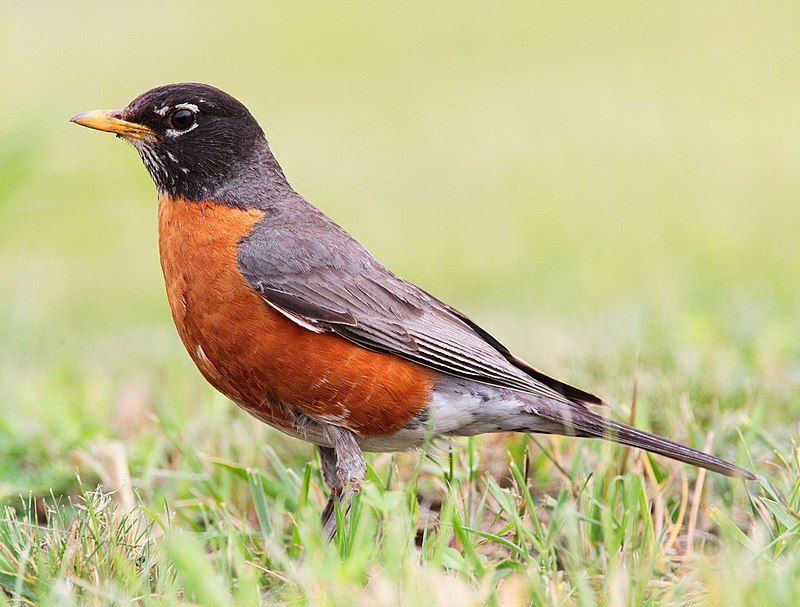
The American robin is a species of migratory bird in the thrush family. It is named after the European robin due to its distinctive reddish-orange breast. Despite their similar appearance, the two species are not closely related.
The American robin is part of the valid thrush genus and Turdidae, while the European robin belongs to the Old World flycatcher family. The American robin is common throughout North America, typically in open woodlands, parks, and gardens.
Its diet consists of insects, fruit, and earthworms, which it forages on the ground. The American robin is a familiar sight in springtime, with its distinctive song and bright orange breast.
| Kingdom | Animalia |
| Phylum | Chordata |
| Class | Aves |
| Order | Passeriformes |
| Family | Turdidae |
| Genus | Turdus |
| Species | T. migratorius |
2. White-Breasted Nuthatch
The white-breasted nuthatch is a species of bird belonging to the Sittidae family. It is a medium-sized species, measuring approximately 15.5 cm in length. This bird is easily identified by its white chest and grey-blue upper parts.
Its black eyes and bill are also distinctive features. Its tail is long and relatively straight, while its wings are short and rounded. The white-breasted nuthatch is primarily found in the eastern United States and Canada, inhabiting woodlands and suburban habitats.
It is an active and agile climber, and it spends much of its time foraging on tree trunks and branches for insects, spiders, and other arthropods.
It also feeds on nuts and seeds, which it can crack open with its strong bill. The white-breasted nuthatch is a sociable bird, often seen in small groups. It is also a vocal species, and its call is a distinctive “yank-yank” sound.
During the breeding season, pairs of white-breasted nuthatches build nests in tree cavities or nest boxes, and the female typically lays four to five eggs.
The white-breasted nuthatch is a distinctive species of bird, easily recognized by its white chest and grey-blue upper parts.
It can be found in woodlands and suburban habitats of the eastern United States and Canada, where it feeds on insects, spiders, and nuts. It is a friendly bird, often seen in small groups, and its call is a distinctive “yank-yank” sound.
| Kingdom | Animalia |
| Phylum | Chordata |
| Class | Aves |
| Order | Passeriformes |
| Family | Sittidae |
| Genus | Sitta |
| Species | S. carolinensis |
3. Northern Cardinal
The northern cardinal (Cardinalis) is a bird species widely recognized for its distinct red plumage. It is commonly called the redbird, common cardinal, red cardinal, or simply cardinal.
This species is found in parts of the United States, Canada, and Mexico and is ubiquitous in North America’s eastern and central areas. It is a medium-sized songbird, typically 8 to 9 inches long and weighing up to 1.5 ounces.
The male has a bright red body and black face, while the female is a more muted brown color with a red band on her face. The northern cardinal’s diet primarily consists of seeds, fruit, and insects. They are also known to visit backyard bird feeders to supplement their diet.
This species is very social and often forms large flocks when foraging for food. The northern cardinal is an essential species in the ecosystem, as it plays a role in seed dispersal and insect control.
| Kingdom | Animalia |
| Phylum | Chordata |
| Class | Aves |
| Order | Passeriformes |
| Family | Cardinalidae |
| Genus | Cardinalis |
| Species | C. cardinalis |
4. American Goldfinch
The American goldfinch is a small, attractive bird found in North America. It belongs to the finch family and is migratory, meaning it travels between different areas throughout the year. It can be found all across mid-Alberta to North Carolina during the breeding season.
It moves from just south of the Canada–United States border to Mexico in the winter. This allows the bird to take advantage of different climates and food sources throughout the year.
The American goldfinch is a colorful and energetic bird that can often be spotted in gardens and parks, where it enjoys feeding on seeds and fruits.
| Kingdom | Animalia |
| Phylum | Chordata |
| Class | Aves |
| Order | Passeriformes |
| Family | Fringillidae |
| Genus | Spinus |
| Species | S. tristis |
5. House Finch
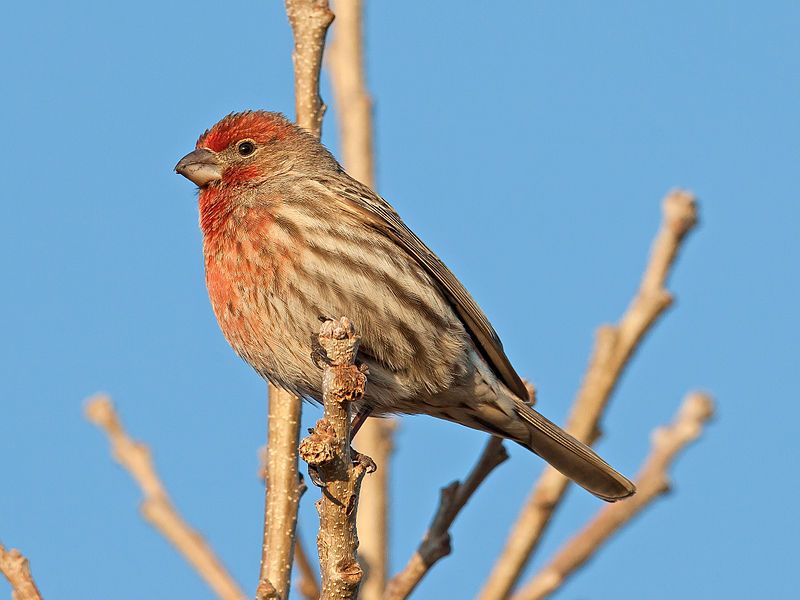
The house finch is a small bird that belongs to the finch family Fringillidae. It is native to the western half of North America, from Canada to Mexico. This species has also been introduced to the eastern half of the continent and Hawaii.
The house finch is one of three species of American rosefinches and is classified in the genus Haemorhous. This species is known for its red-colored plumage, which is especially visible during the breeding season.
The house finch is a common bird in urban areas and is often seen in backyards. It feeds mainly on seeds, as well as fruits and insects. It builds cup-shaped nests in trees and bushes and lays up to six eggs in each clutch.
This species is relatively common and is not considered threatened at this time.
| Kingdom | Animalia |
| Phylum | Chordata |
| Class | Aves |
| Order | Passeriformes |
| Family | Fringillidae |
| Genus | Haemorhous |
| Species | H. mexicanus |
6. House Sparrow
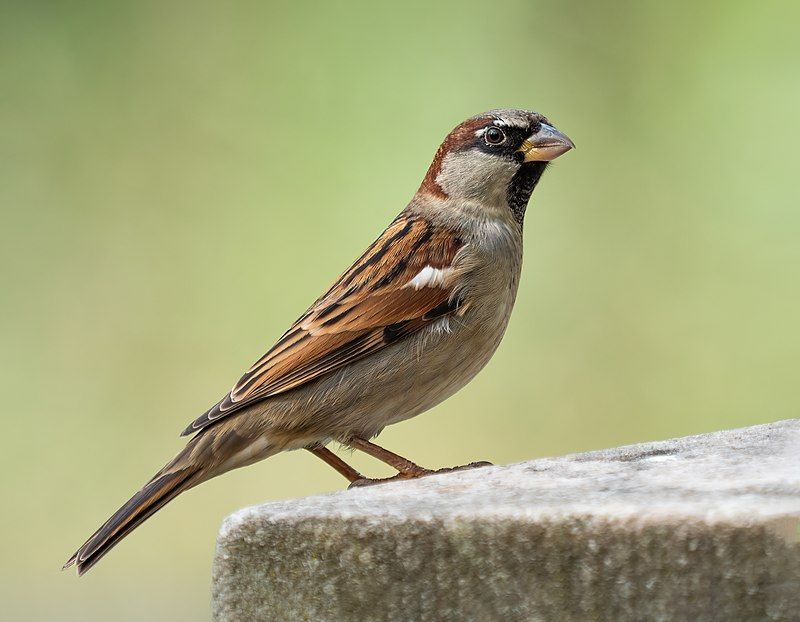
The house sparrow is a widespread bird species in many parts of the world. It is a small bird, measuring approximately 16 cm in length, and has a 24 to 39.5 g mass.
Females and juveniles of this species have pale brown and grey plumage, while males have more vibrant black, white, and brown markings. This species belongs to the sparrow family Passeridae, composed of several small passerine birds.
The house sparrow is an adaptable and highly social species, often found in flocks in urban areas. They are omnivores, eating various foods, including small insects, grains, and fruits. In addition, they frequently use grass and other plant material to construct their nests.
The house sparrow is a significant species in many parts of the world and is often considered a symbol of friendship and peace. As a result, it is a widely appreciated and celebrated species.
| Kingdom | Animalia |
| Phylum | Chordata |
| Class | Aves |
| Order | Passeriformes |
| Family | Passeridae |
| Genus | Passer |
| Species | P. domesticus |
7. Tufted Titmouse
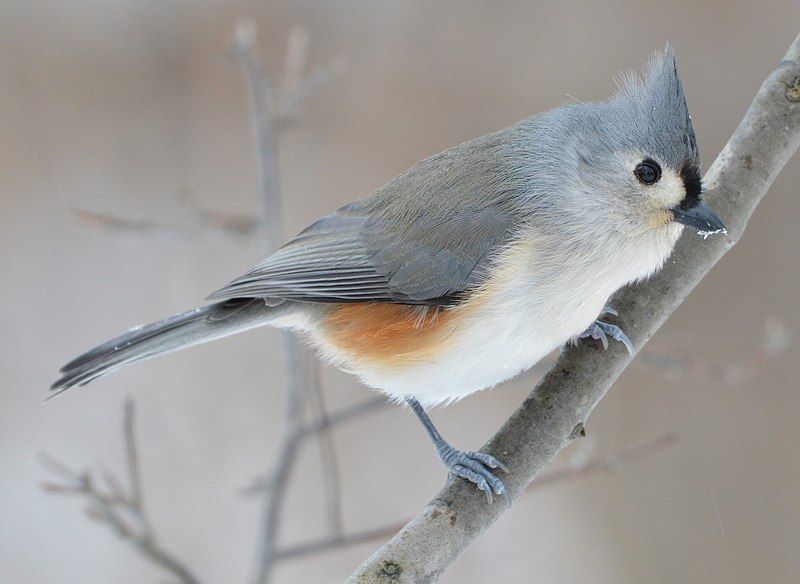
The tufted titmouse is a small songbird found in North America and is a member of the tit and chickadee family. It is typically gray and has a distinctive tufted crest on its head. This species can be found from southern Canada to northern Mexico.
In addition, the black-crested titmouse is also found in this region, from central and southern Texas southward. This species was once considered a subspecies of the tufted titmouse but has since been reclassified as its species, Baeolophus atricristatus.
Due to its black crest, the black-crested titmouse is easily distinguishable from the tufted titmouse. Both species are omnivorous and feed on various insects, fruits, and seeds. They are also both known for their loud and complex songs.
| Kingdom | Animalia |
| Phylum | Chordata |
| Class | Aves |
| Order | Passeriformes |
| Family | Paridae |
| Genus | Baeolophus |
| Species | B. bicolor |
8. Mourning Dove
The mourning dove is a bird native to the Americas that belongs to the family Columbidae, which includes over 300 different species of doves and pigeons.
The mourning dove is also known by several other names, including the American mourning dove, the rain dove, and, colloquially, the turtle dove.
In the past, the mourning dove was known as the Carolina pigeon and Carolina turtledove, but these nicknames have been largely forgotten. The mourning dove is a medium-sized bird, reaching lengths of between 28 and 33 centimeters and weighing roughly 70 to 120 grams.
Its wings, tail, and body are grayish-brown, while its underside is pale pinkish-gray. Males and females look similar, with males having slightly brighter plumage and larger body sizes.
The mourning dove has a distinctive call that sounds like “coo-OO-ah,” often used as a soundtrack in movies and television shows to suggest a peaceful atmosphere.
The mourning dove is found across North and Central America, from southern Canada to northern South America. The birds prefer open habitats such as grasslands, fields, and woodlands and can often be seen foraging on the ground for seeds and grains.
They are monogamous birds, meaning they form pairs with one partner for life, and they typically lay two eggs in a nest made of sticks and twigs. The mourning dove is a widely recognized species, and it has been featured on postage stamps and conservation coins.
| Kingdom | Animalia |
| Phylum | Chordata |
| Class | Aves |
| Order | Columbiformes |
| Family | Columbidae |
| Genus | Zenaida |
| Species | Z. macroura |
9. Canada Goose
The Canada goose is a large wild goose with a distinctive appearance. It has a black head and neck, white cheeks, and a white chin. Its body is mostly brown. This species is native to North America, living in the Arctic and temperate regions.
It is also known to make a long journey across the Atlantic to northern Europe, although this is not a regular occurrence. The Canada goose is an easily recognizable bird found in many places in North America.
It is a common sight in parks, fields, and other open areas. They are typically seen in flocks, often numbering in the thousands. They are usually quite vocal and are known for their honking call. The Canada goose is an essential species in many ecosystems.
Their droppings provide nutrients to the soil, which helps support other wildlife. They also play a part in controlling the insect population, which helps keep the mosquito population down.
Additionally, they are an essential food source for many predators, such as foxes, coyotes, and bears. The Canada goose is considered to be a unique species by many people. They are often seen as an iconic symbol of wilderness and freedom.
They are also a popular subject in art and photography. People often enjoy watching the graceful flight of these beautiful birds and are frequently inspired by their incredible migratory journeys.
| Kingdom | Animalia |
| Phylum | Chordata |
| Class | Aves |
| Order | Anseriformes |
| Family | Anatidae |
| Genus | Branta |
| Species | B. canadensis |
10. American Crow

The American crow is a large passerine bird species belonging to the Corvidae family. It is a common bird found in many areas of North America. It is the New World counterpart of the carrion crow and the hooded crow from Eurasia.
All these birds occupy the same ecological niche, meaning they all have similar environmental roles. They feed on the same type of food, live in the same habitat, and compete for resources, which contributes to the balance of the ecosystem.
American crows are considered to be intelligent birds and are known to recognize individual humans. They are also known to be resourceful, often finding and using human-made tools to obtain food.
They are also known to be good problem solvers capable of adapting and adjusting to their environment.
| Kingdom | Animalia |
| Phylum | Chordata |
| Class | Aves |
| Order | Passeriformes |
| Family | Corvidae |
| Genus | Corvus |
| Species | C. brachyrhynchos |
11. Downy Woodpecker
The Downy Woodpecker is a species of woodpecker found in North America and is the smallest in the region. These woodpeckers have a length ranging from 14 to 18 cm.
Downy Woodpeckers are mainly concentrated in forested areas throughout the United States and Canada, except for the southwestern deserts and the northern tundra.
These birds are often seen foraging on tree trunks and branches for food, such as insects, larvae, and even small fruits. Downy Woodpeckers also nest in trees and prefer to stay near the ground.
They are exceptionally social birds and can be seen in small flocks during the winter months. In addition to their forested habitats, Downy Woodpeckers also inhabit gardens, parks, orchards, and farmlands.
| Kingdom | Animalia |
| Phylum | Chordata |
| Class | Aves |
| Order | Piciformes |
| Family | Picidae |
| Genus | Dryobates |
| Species | D. pubescens |
12. Dark-Eyed junco

The dark-eyed junco is a species of junco, a group of small, grayish sparrows originating from the New World. This type of bird is quite common across North America, and in the summertime, it can also be found in the Arctic.
This species is highly variable, which can be easily confused with the related fox sparrow species.
Additionally, the systematics of the dark-eyed junco have not yet been entirely untangled, so more research is still needed to understand this bird fully.
| Kingdom | Animalia |
| Phylum | Chordata |
| Class | Aves |
| Order | Passeriformes |
| Family | Passerellidae |
| Genus | Junco |
| Species | J. hyemalis |
13. Blue Jay
The blue jay is a type of bird in the Corvidae family native to the eastern side of North America. It is found in most of the eastern and central parts of the United States, and many of these populations are migratory.
It can also be found in Newfoundland, Canada, and breeding populations across southern Canada. In other words, the blue jay is widespread in a large area of North America, from the United States to Canada.
The blue jay is a beautiful bird well-known for its bright blue plumage and white markings. They are social birds and are often seen in groups. They have a wide variety of calls and are known to mimic the sounds of other birds.
They are also brilliant and can remember where they have hidden food. Blue jays mainly feed on seeds, grains, insects, and small invertebrates. They will also eat fruits, nuts, and nectar from flowers.
They have also been known to raid bird feeders and scavenge from other sources. Blue jays are essential seed dispersers and are crucial in maintaining healthy ecosystems. The blue jay is a fascinating bird that has become a beloved part of many people’s lives.
It is an iconic symbol of North America and can be found in many parks and gardens across the continent.
| Kingdom | Animalia |
| Phylum | Chordata |
| Class | Aves |
| Order | Passeriformes |
| Family | Corvidae |
| Genus | Cyanocitta |
| Species | C. cristata |
14. Red-Bellied Woodpecker
The red-bellied woodpecker is a bird species found in the family Picidae. It is considered to be a medium-sized woodpecker that can be found throughout the eastern United States.
This woodpecker species can be found as far south as Florida and north as Canada, making it a prevalent species.
The red-bellied woodpecker is one of the most common species found in the eastern United States and is a famous sight to birders and wildlife observers.
This species is often seen foraging for food on tree branches and is known for its distinctive red coloring on the underside of its body. The red-bellied woodpecker is primarily insectivorous but also feeds on fruits and nuts.
In addition to being found in the wild, this species is sometimes kept as a pet.
| Kingdom | Animalia |
| Phylum | Chordata |
| Class | Aves |
| Order | Piciformes |
| Family | Picidae |
| Genus | Melanerpes |
| Species | M. carolinus |
15. Red-Winged Blackbird
The red-winged blackbird is a type of songbird that belongs to the Icteridae family. This bird is native to most of North America and Central America. It is known for its striking appearance, with a glossy black body, bright red and yellow wings, and a long, pointed beak.
The red-winged blackbird is also known for its loud and melodic song. This species is found throughout wetlands, including marshes, swamps, and ponds. They are also found in fields, grasslands, and urban areas. They feed on insects, seeds, berries, and other small invertebrates.
The red-winged blackbird is an integral part of many ecosystems in North and Central America. The red-winged blackbird is also an essential part of Native American culture. It is featured in traditional stories and symbolizes joy, freedom, and the renewal of life.
The bird is also featured in many songs and artwork. The red-winged blackbird is a vibrant and vital species of songbird. It is found in many parts of North and Central America and is essential in ecosystems and culture.
| Kingdom | Animalia |
| Phylum | Chordata |
| Class | Aves |
| Order | Passeriformes |
| Family | Icteridae |
| Genus | Agelaius |
| Species | A. phoeniceus |
16. European Starling
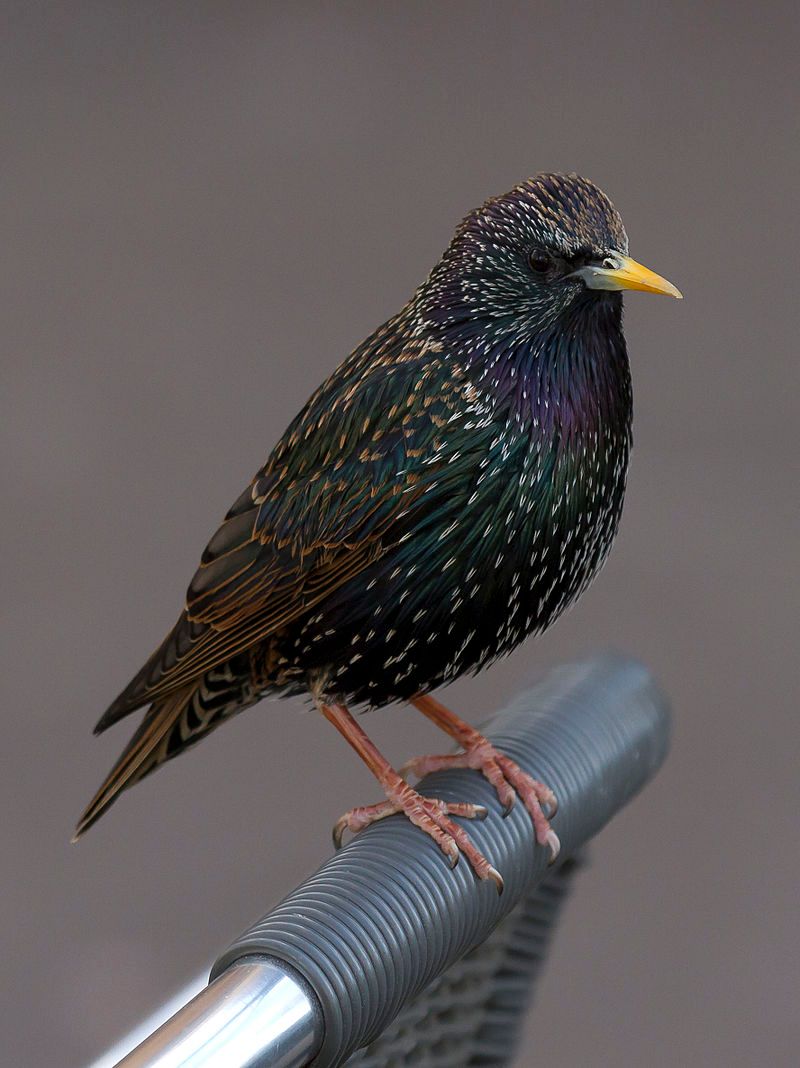
The common Starling is a type of bird found in various regions worldwide. It is also known as the European Starling in North America and the Starling in Great Britain and Ireland.
It is classified as a medium-sized passerine bird from the starling family Sturnidae. The common Starling is a small to medium-sized bird, typically measuring 20 and 25 cm long and weighing 35 and 50 g.
The plumage is primarily black, with a glossy sheen and white spots. Their bills are short and pointed, and they have short legs and long tails.
They also have a distinctive song, with various whistles, trills, and chirps. Common starlings are found in open habitats, including woodlands, grasslands, and agricultural areas. They are omnivorous, feeding on various insects, fruit, and seeds.
They are also known to eat eggs and nestlings of other birds. Common starlings are highly sociable birds. They often flock together in large numbers, sometimes thousands of birds, and can be seen gathering in huge flocks in winter.
They are also known to be quite noisy and can be heard in the evening or near dusk. The common Starling is an essential species for the environment, playing a pivotal role in controlling insect populations and dispersing seeds.
They are also an essential part of our culture, having been featured in literature, art, and music.
| Kingdom | Animalia |
| Phylum | Chordata |
| Class | Aves |
| Order | Passeriformes |
| Family | Sturnidae |
| Genus | Sturnus |
| Species | S. vulgaris |
17. Black-Capped Chickadee
The black-capped chickadee is a small, cheerful songbird found in deciduous, mixed forests throughout North America. It is a member of the tit family (Paridae), which consists of tiny birds with long tails and short wings.
This bird is the state bird of Massachusetts and Maine in the United States and the provincial bird of New Brunswick in Canada. The black-capped chickadee is a non-migratory bird, which means it spends its entire life in the same area.
They feed on various seeds, fruits, and insects, often storing food for the winter.
They are also highly sociable birds and can often be found in small flocks. The male and female black-capped chickadee look similar, with black caps, white cheeks, grey backs, and white chests.
The bird’s call is a short, distinctive “chick-a-dee-dee-dee,” which is how it got its name. In addition to being a symbol of national pride in the US and Canada, the black-capped chickadee is an integral part of the North American ecosystem.
These birds help to control insect populations and spread seeds from plants, making them vital to the health of their environment.
| Kingdom | Animalia |
| Phylum | Chordata |
| Class | Aves |
| Order | Passeriformes |
| Family | Paridae |
| Genus | Poecile |
| Species | P. atricapillus |
18. Song Sparrow
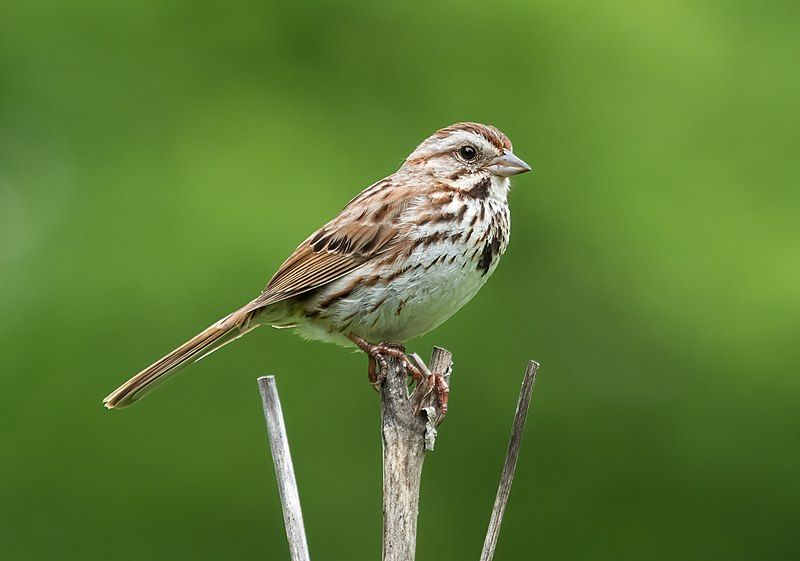
The song sparrow is a common bird found in North America. It is a medium-sized sparrow, approximately 5-6 inches long, and has a brown back, white belly, and gray wings. It is easily the most abundant and variable of the native sparrow species in North America.
The song sparrow can be found in various habitats, from forests, grasslands, and wetlands to urban and suburban areas, making it one of the most adaptable species in the region.
It has many habitats and can be spotted in open fields, meadows, and nearby buildings and homes. The song sparrow feeds on insects, seeds, grains, and berries and is most active during the day, making it a common sight in many parts of North America.
| Kingdom | Animalia |
| Phylum | Chordata |
| Class | Aves |
| Order | Passeriformes |
| Family | Passerellidae |
| Genus | Melospiza |
| Species | M. melodia |
19. WhiteThroated Sparrow
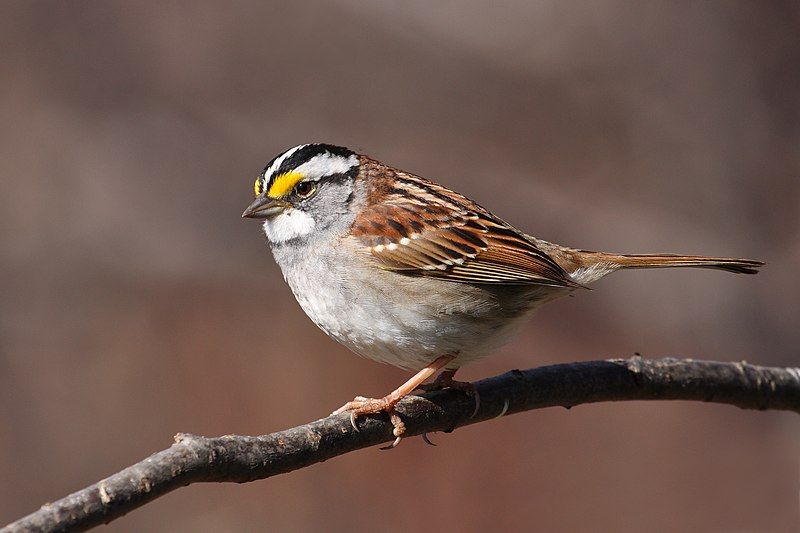
The white-throated sparrow is a small, migratory bird belonging to the family of birds known as Passerellidae. It is found primarily in North America and is known for its distinctive white throat and yellow markings.
The species can be found in various habitats, such as grasslands, woodlands, marshes, and even urban areas. During the breeding season, which runs from April to August, the male is easily identified by its grey head and white throat.
Its brown head and white throat quickly identify the female. The white-throated sparrow is often found in flocks with other species of sparrows and is known to be exceptionally social.
They feed mainly on tiny seeds and insects but eat fruits, berries, and other plant materials. Their song is a series of loud, high-pitched notes.
The white-throated sparrow is an integral part of North American ecosystems, providing food for many predators, including hawks, owls, and foxes. The species is listed as a species of most minor concern by the International Union for Conservation of Nature (IUCN).
| Kingdom | Animalia |
| Phylum | Chordata |
| Class | Aves |
| Order | Passeriformes |
| Family | Passerellidae |
| Genus | Zonotrichia |
| Species | Z. albicollis |
20. Northern Flicker
The northern flicker, also known as the familiar flicker, is a species of woodpecker found across North America. It is a medium-sized bird with distinctively patterned plumage.
The northern flicker is found in almost all of North America and parts of Central America, Cuba, and the Cayman Islands. It is one of the few woodpecker species that migrate.
During the breeding season, the northern flicker prefers open woodlands with nearby meadows, while in winter, it may be found in more open habitats like fields and parks. The north flicker feeds on various foods, including ants, fruits, berries, and seeds.
Its diet also includes insects, such as beetle larvae and caterpillars. It has a unique way of foraging by using its long tongue to gather insects from the ground or crevices in trees and logs.
The northern flicker is also a cavity nester, creating a nest in a hollowed-out tree or logs.
The male flicker often drums on trees to attract potential mates. The northern flicker is an essential species in North American ecosystems, providing vital ecological services such as dispersing seeds and controlling insect populations.
Its unique feeding behavior and cavity-nesting habits make it an important species to study for those interested in understanding the ecology of woodlands.
| Kingdom | Animalia |
| Phylum | Chordata |
| Class | Aves |
| Order | Piciformes |
| Family | Picidae |
| Genus | Colaptes |
| Species | C. auratus |
21. Eastern Bluebird
The Eastern Bluebird is a species of thrush native to North America known for its bright blue breeding plumage. It is a migratory bird, found in open woodlands, farmlands, orchards, and often seen perched on wires or other open perches.
Its beautiful colors and tendency to perch in open areas make it a favorite of birders. The Eastern Bluebird is typically a tiny bird with a wingspan of up to 17 inches and a body length of 6-7 inches.
The male has a bright blue back, wings, and tail, as well as a reddish-orange breast.
The female is a duller gray-brown color, with a buff-colored breast. This species is a ground-dweller, nesting in various places ranging from tree cavities to old boxes or birdhouses.
The female lays three to six eggs in the nest and incubates them for about two weeks before they hatch.
Both parents feed the young birds and leave the nest after about two weeks. The Eastern Bluebird is an essential species in its ecosystem, providing food for predators and pollinating flowers and other plants.
Its diet consists mainly of insects, fruits, and berries, and it is an important food source for birds of prey, such as hawks and owls. The Eastern Bluebird’s bright blue plumage and tendency to perch in open areas make it a favorite of birders.
This species is a delight to watch and a great addition to any backyard habitat.
| Kingdom | Animalia |
| Phylum | Chordata |
| Class | Aves |
| Order | Passeriformes |
| Family | Turdidae |
| Genus | Sialia |
| Species | S. sialis |
22. Common Grackle
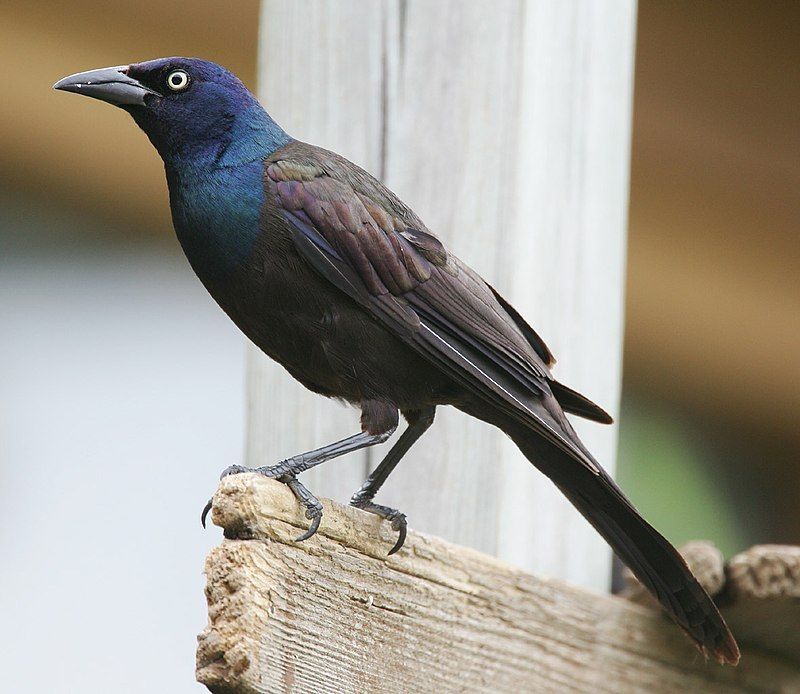
The common grackle is a species of large icterid bird found throughout North America. This species was first identified and described in 1758 by Carl Linnaeus, one of the fathers of modern taxonomy.
Common grackles can easily be distinguished by their long, dark bills, pale yellow eyes, and long tails.
The species is divided into three subspecies according to their geographical distributions: the Great-tailed Grackle, the Boat-tailed Grackle, and the Common Grackle. The Great-tailed Grackle can be found in the southwestern United States and northern Mexico.
They are generally more significant than the other two subspecies, with a length of up to 13.5 inches and a wingspan of up to 22 inches. The Boat-tailed Grackle, on the other hand, is usually found in coastal regions of the southeastern United States.
They are slightly smaller than the Great-tailed Grackle, with a length of 10-13 inches and a wingspan of 17-20 inches. The Common Grackle is the most widespread of the three subspecies and is found throughout most of North America.
It has a length of 7.9-10.6 inches and a wingspan of 12-14 inches. Common grackles are omnivorous; they feed on various insects, seeds, grains, fruits, and even small vertebrates.
They have also adapted to living in urban environments, where they can be seen perched on rooftops or telephone wires.
Although common grackles may be seen as a pest species due to their large flocks and loud calls, they are essential contributors to their ecosystems as they help to keep insect populations in check and spread the seeds of plants.
| Kingdom | Animalia |
| Phylum | Chordata |
| Class | Aves |
| Order | Passeriformes |
| Family | Icteridae |
| Genus | Quiscalus |
| Species | Q. quiscula |
23. Chipping Sparrow
The chipping sparrow is a small passerine bird species belonging to the Passerellidae family. This species is found across much of North America and is known for being relatively tame, meaning humans do not easily scare it away.
There are two distinct subspecies of chipping sparrows: the eastern and western chipping sparrows.
Both subspecies can be found in different areas of North America, with the eastern chipping sparrow covering most of the eastern United States and parts of Canada. In contrast, the western chipping sparrow inhabits most of the west of the United States and parts of Canada and Mexico.
Both subspecies have similar features, including brownish-grey plumage, a white belly, and a white stripe above the eye. They are also known for their distinct chipping song.
The chipping sparrow is a beneficial species to humans, as they consume a variety of insects, as well as weed seeds and grains. They also provide an excellent food source for many other animals, such as hawks and owls.
In addition, they are relatively easy to observe in rural and urban areas, making them a famous bird for birders. The chipping sparrow is a widespread bird species found across much of North America.
With its two distinct subspecies, the eastern and western chipping sparrow, this species provides various benefits to humans and an enjoyable birding experience.
| Kingdom | Animalia |
| Phylum | Chordata |
| Class | Aves |
| Order | Passeriformes |
| Family | Passerellidae |
| Genus | Spizella |
| Species | S. passerina |
24. Ruby-Throated Hummingbird
The ruby-throated hummingbird is a species of hummingbird that has an annual migratory cycle. They can be found in Central America, Mexico, and Florida during the winter season.
As the summer season approaches, these birds migrate to Canada and other parts of Eastern North America. This journey is undertaken for the sole purpose of breeding.
During this time, their diet consists of nectar and insects, which they feed on while flying from flower to flower. They also collect sap from trees and eat small berries and seeds.
This hummingbird species is relatively small, with a length of around 3-4 inches and an average weight of about 3 grams. They are easily recognized by their bright red throat feathers, which contrast with the green and white feathers of the rest of their body.
| Kingdom | Animalia |
| Phylum | Chordata |
| Class | Aves |
| Clade | Strisores |
| Order | Apodiformes |
| Family | Trochilidae |
| Genus | Archilochus |
| Species | A. colubris |
Conclusion
Birds of the Northeastern United States are a diverse and varied group, with species ranging from robins and warblers to hawks and owls.
Birders and birdwatchers from all walks of life enjoy observing these birds in their natural habitat.
With careful observation and appreciation of the natural world, we can continue to appreciate the beauty of the birds of the Northeastern United States.